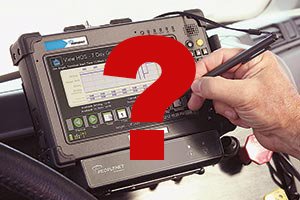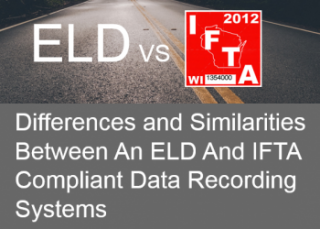
Choosing an ELD? Use Caution
posted in Blog by Brian Gray
Choosing an ELD? Use Caution
“It is important for carriers to conduct due diligence on an ELD provider, their solution and their testing procedures. Ultimately, it will be the carrier that will inevitably run the risk of non-compliance with the regulations if the ELD solution malfunctions or is removed from the registry; as a potentially high stakes consequence, this could have a fleet running without a solution.” – EROAD
As you are now well aware, the FMCSA published the Final Rule requiring carriers and drivers currently using paper record of duty status (RODS) to adopt electronic logging devices (ELDs). The timeline is straight forward. Drivers must transition to using “compliant ELDs” by December 2017 unless they have automatic on-board recording devices (AOBRDs) that are grandfathered under this rule. This means that drivers using AOBRDs must also transition to using “compliant ELDs”, but they will have an additional two years to do so (until December 2019).
The decision to replace paper logbooks with an electronic solution requires a major commitment from drivers and carriers. Although you are being mandated to use ELDs, it is critical that you find the right ELD solution appropriate to you operations, business needs, driver preferences, and budget.
Self-Certified “Compliant ELDs” and What This Means
Many in the trucking industry are pushing hard to start the transition to ELDs in trucks as early as possible. There are lots of companies putting together webinars and trainings that details what to look for in an ELD. However, like other early adopters of new technologies, carriers who are proactive in implementing ELDs in their operations may be at greater risk of being solicited by opportunistic manufacturers who are not really ready to bring their product to market or who have dishonestly claimed that their ELD product meets the FMCSA self-certification standards. We suggest you create a plan when choosing the right ELD for your company.
The Final Rule sets out details of the technical standards and functional specifications for an ELD to be considered compliant and eligible for self-certification and registration on the FMCSA website. The ELD testing guidelines offered by the FMCSA run to 454 pages, which can significantly lengthen the time needed to ensure the devices are properly certified:
“For an ELD provider, getting on the ELD registry is the easy part. The challenging part for ELD providers will be to remain on the registry, which depends on having a compliant product that truly works for the drivers and carriers in all manners of commercial vehicle operation.” – EROAD
There have been some early additions to the list of registered ELDs on the FMCSA’s website. As the FMCSA points out, these devices are self-certified by the manufacturer and not by the Federal Motor Carrier Safety Administration. Also, remember that the ultimate responsibility for compliance will fall upon the carrier, so buyer beware. Self-certification does not guarantee compliance.
Remember, ELDs do not need to be technically “certified” until Dec. 18 of 2017 so fleets adopting them now have a time window in which adjustments can be made.
Who to Trust?
The big names in the EOBR, AOBRD, or other in-the-truck software companies like GeoTab, Omnitracs, Fleetmatics, and EROAD have yet to have their products registered on the FMCSA website. These companies are taking their time to ensure their products are market-ready and some industry analysts expect these manufacturers to register their devices with the FMCSA by the end of 2016 or early 2017.
“A confident ELD provider will be open and transparent around the technical development, testing frameworks and user feedback incorporated into their solution. A carrier should expect a clear and supported pathway for transitioning from the current state – using paper, AOBRD or electronic logs – to adopting an ELD solution that ideally brings alongside other complementary solutions across the business.” – EROAD
The Basic Requirements
A compliant ELD solution must include:
- The ability to record data from the vehicle ECM
- The ability to record vehicle location
- The ability to display a log graph grid of driver’s daily duty status
- The ability power-on within one minute of the engine powering-on
- The ability to record unidentified driving events when a driver is not logged into their ELD
- The ability to visual display a malfunction indicator
- The ability to transfer data via web services and email or via USB and Bluetooth
- The ability for drivers can modify their duty status records, with the carrier only being able to make suggestions.
A few critical points about ELDs:
- Make sure driver log in/long off and commercial vehicle power on/power data is being captured by the ELD.
- The driver must certify the ELD data at the beginning and end of the day and any edits made by in the “back office” must be reviewed by the driver and certified.
- Watch how you set up unassigned vehicle moves, such as technicians taking vehicles out for road tests. If no one logs in, the “movement” goes to the driver assigned to vehicle – and if there are too many unreconciled “moves” this create a problem during DOT audits.
- The ELD rule very specifically says that if the vehicle identification number (VIN) date code is 2000 or newer, you are required to have an ELD. If the VIN date is older than 2000, you are not required to have an ELD, but that does not alleviate the fact that the driver must keep a paper logbook.
- It is the VIN number on the truck that matters, NOT the age of the engine. That means fleets using glider kits that are model year 2000 or newer must use ELDs.
- One important caveat for “short haul” drivers operating within a 100 mile radius of their home base: If they break the 100 mile limit more than eight times in 30 day period, they will need to use an ELD for 30 days. However, that determination is made driver by driver; an entire short haul fleet is not affected if just one of its drivers is tagged to use an ELD.
Where Should You Start?
The first step is to sit down with your staff and discuss what you want the ELD solution to do for you. There are a lot of great features and tracking data that can be incorporated into these devices, but your team should create a game plan, budget, and plan on testing a couple of solutions before making your final choice so you only buy what you really need.
Another way to buy more time is for a fleet or owner-operator to adopt automatic onboard recording devices or “AOBRDs” ahead of the 2017 ELD adoption deadline.
“If you install an AOBRD prior to Dec. 18 of 2017 you come into the grandfather clause – you get an additional two years beyond initial [ELD] compliance date,” Cuthbertson said.
This might be a wise choice for some fleets as he indicated ELD parameters remain in a “messy state” right now.
Contact one of our experts at Glostone Trucking Solutions for a device recommendation that will fit your needs at 503-607-1088.







